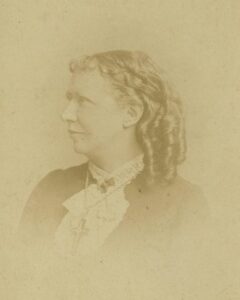
Ellen Murray
*Ellen Murray was born on this date in 1834. She was a white-American teacher and education administrator.
Murray was one of three girls born in St. Johns, New Brunswick, Canada. Her father died when she was two years old, leaving behind enough wealth for his three daughters to receive education in Europe. Murray was fluent in English, French, and German. The family bought a home in Newport, Rhode Island, where she became a teacher. In Newport, she met Laura M. Towne of Philadelphia when Towne came to speak to local Rhode Island Quakers about slavery.
On November 7, 1861, Union forces captured the Port Royal Sound area, including numerous Sea Island plantations and Beaufort. Local white planters fled the area, leaving approximately 10,000 enslaved people still living on these islands. When news of the capture reached Northern cities, Laura Towne was among the first abolitionists to arrive in Beaufort in the spring of 1862.
Murray arrived in Beaufort County on June 8, 1862. A few weeks later, she taught her first classes at the Oaks Plantation, and later that year, in August, Ellen decided to start teaching in a church on St. Helena Island known as the Brick Church. Built in 1855 by enslaved people whose fingerprints remain in the brick, the Brick Church would be the start of over a century of education on St. Helena Island. Murray taught the youngest and eldest children, while Towne taught the "middle" children. Later in the day, she would teach the adults while Towne attended to the medical needs of newly freed people on St. Helena.
While in South Carolina, Ellen wrote poetry and published it in the National Anti-Slavery Standard. Charlotte Forten joined Ellen Murray and Laura Towne in the fall of 1862. In January 1865, a prefabricated building sent by the Pennsylvania Freedmen's Relief Commission arrived on St. Helena Island. Murray and Towne moved their school into this building, naming it Penn School after Pennsylvania founder William Penn.
Penn School would serve as a high school on St. Helena Island, with a curriculum including "reading, spelling, writing, geography, grammar, and arithmetic." In 1868, Murray and Towne began teacher training at Penn, and by 1870, several teachers trained at Penn were hired by the state of South Carolina to teach in public schools. Teacher training would remain an essential part of Penn School's curriculum throughout its history. As the will to prosecute Reconstruction waned in the 1870s, so did the funds from Northern aid societies. The Pennsylvania Freedmen's Relief Association closed in 1871, "entrusting its last funds to the Benezet Society of Germantown," which continued supporting Penn School until 1877. When funds grew short, Murray and Towne refused salaries to keep the school funded.
After the death of Laura's brother, Henry, in 1875, the funds left in his will were used to help keep the school afloat in lean times. Both Murray's and Towne's families donated funds to Penn School. Despite the financial hardships of the late 1800s, Murray and Towne persevered. With the school and its curriculum firmly established, Penn School continued educating freed people on St. Helena Island throughout the nineteenth century. She continued teaching until the day before her death on January 14, 1908. A memorial service for Ellen Murray was held in Darrah Hall on the Penn School campus. Her memorial and Laura Towne's overlook the location where their schoolhouse and their life's work stood.
To Become an Elementary School Teacher
To Become a Middle School Teacher
To become a High School Teacher